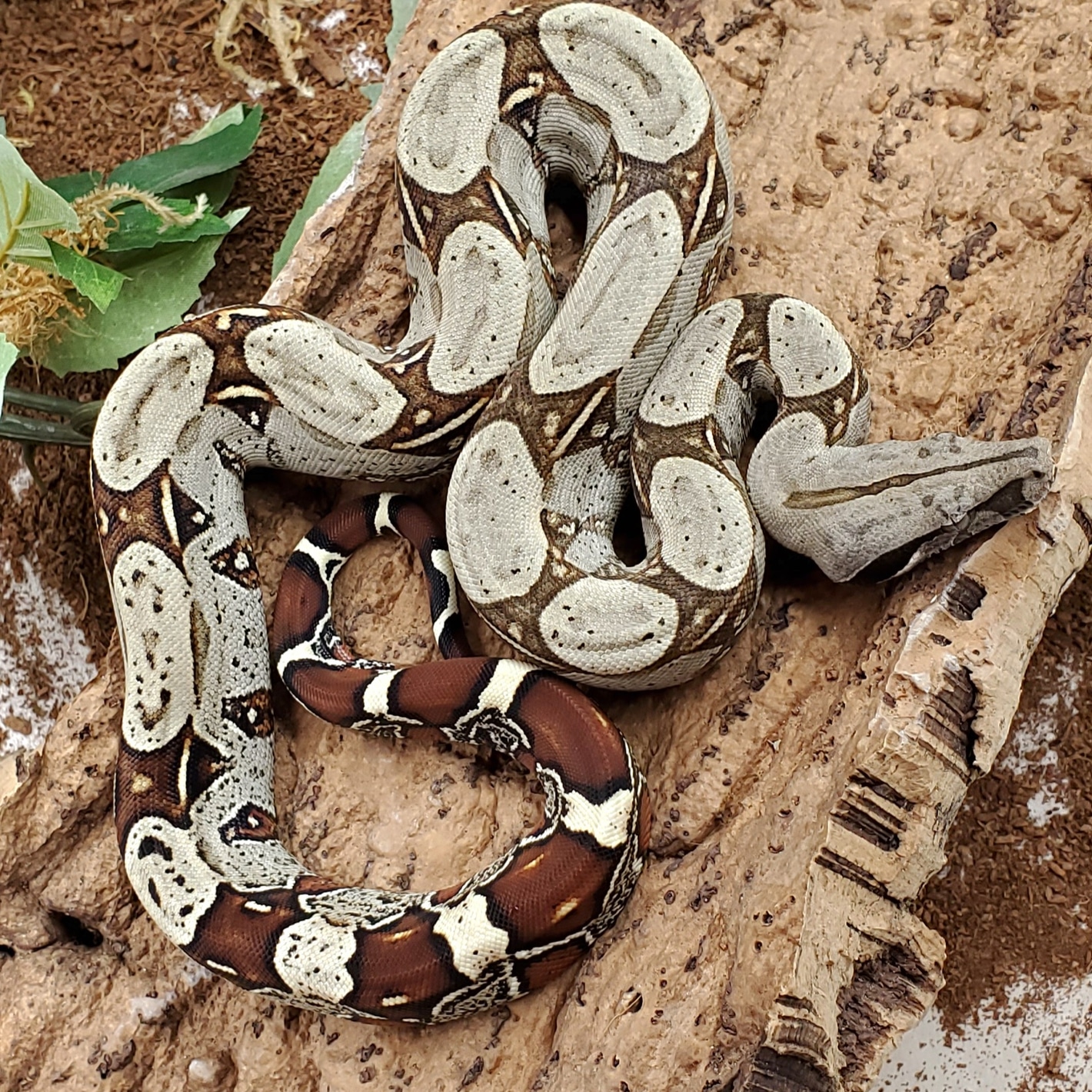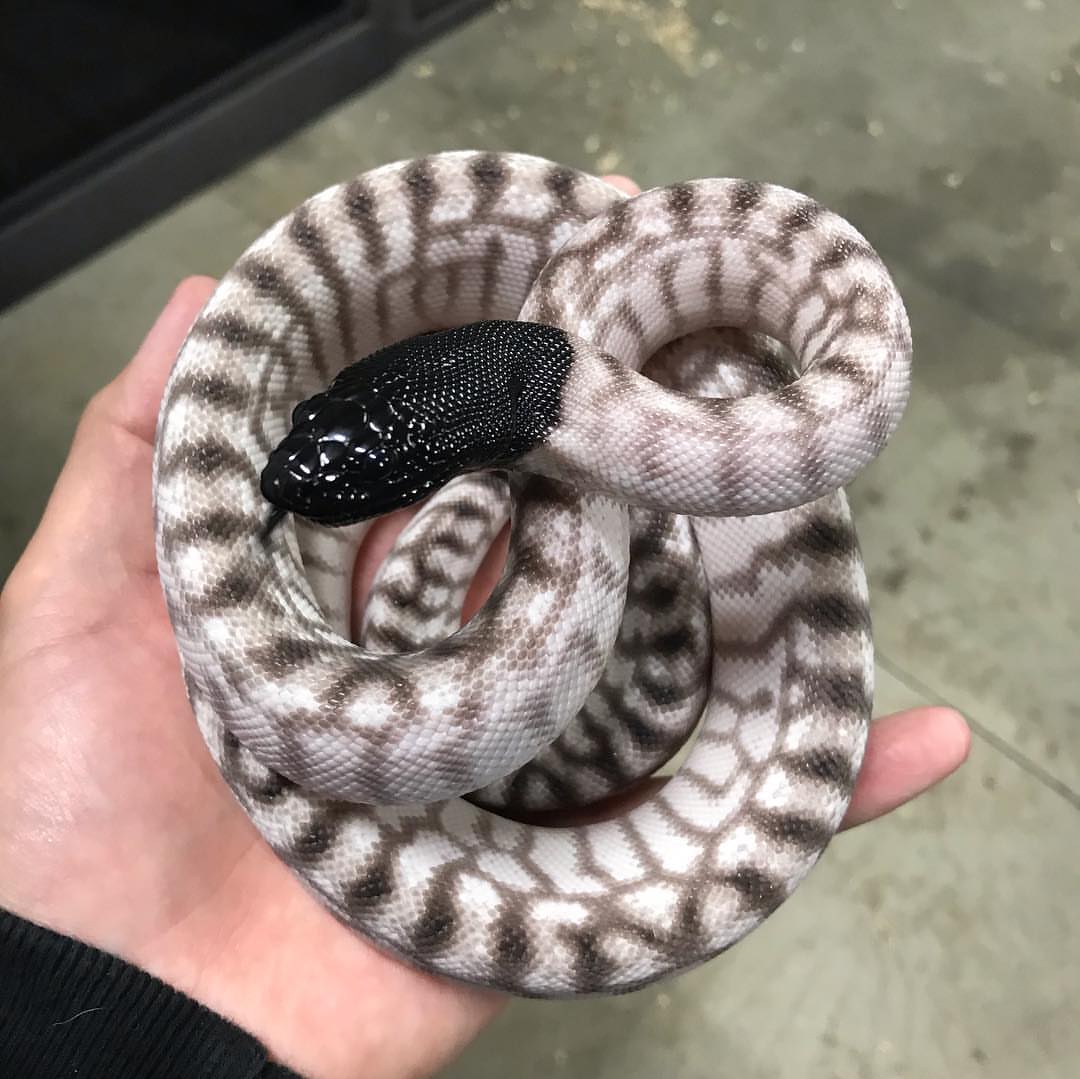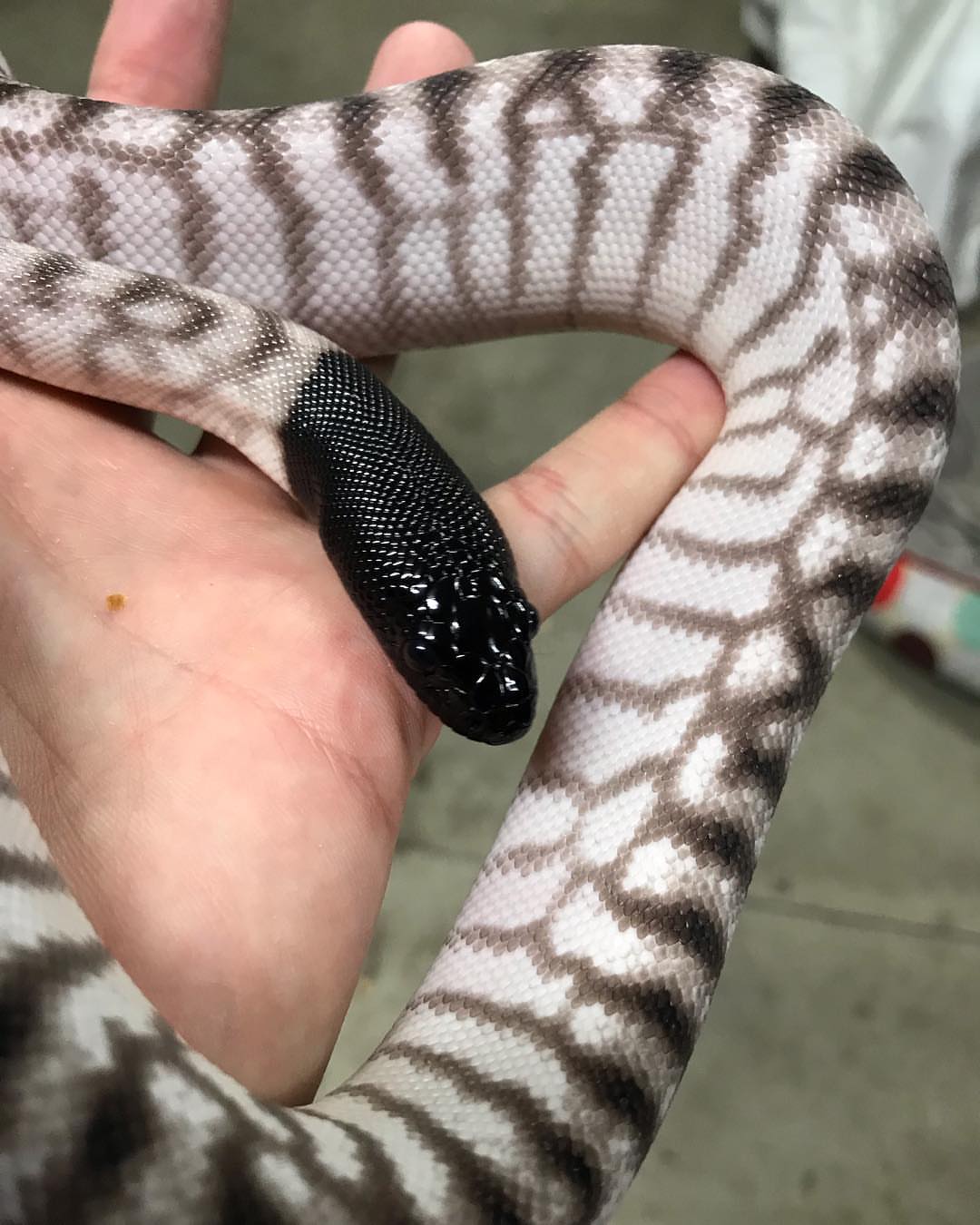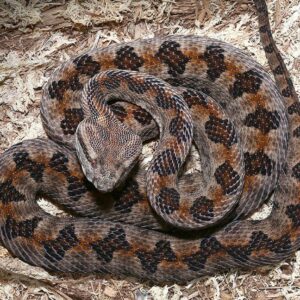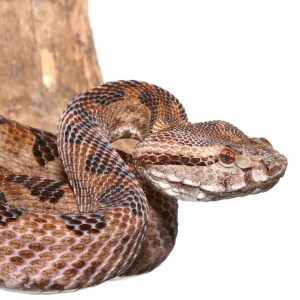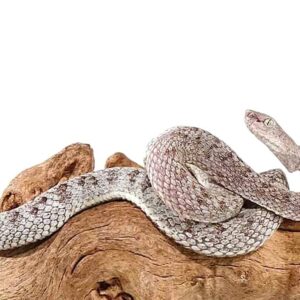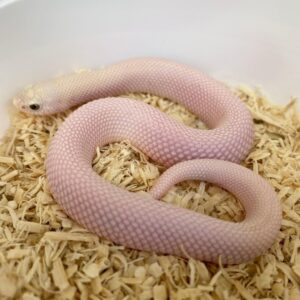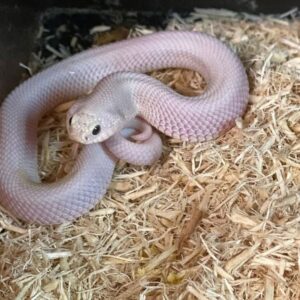Axanthic Black Headed Python For Sale
$2,199.00
Black-headed python (Aspidites melanocephalus ) is a species of non-venomous snake in the Pythonidae (the python family). Being naturally non-venomous, these snakes must constrict their prey to suffocate it prior to consumption.
Habits and Lifestyle
Axanthic Black Headed Python are ground-dwelling creatures and are often found amongst rocks and loose debris. If disturbed, they hiss loudly but are unlikely to bite unless hunting prey. They sometimes strike with a closed mouth, but generally can be handled easily. These pythons are strong swimmers, but they almost never spend time in the water.
To cool themselves, Axanthic Black Headed Python may bury their dark head in the sand.
Furthermore,
Black-headed pythons are nocturnal and spend their time single. Because they live in the tropics, they heat up quicker and stay warmer for longer.
This means they can eat more because they digest food quicker in warmer conditions.
When ingesting large prey, Black-headed python position one or two coils just ahead of their distended mouths and by constriction make the task of swallowing prey easier.
Diet and Nutrition
Black-headed pythons are carnivores. They prey mainly on reptiles, including snakes but will also eat mammals if available.
DIET Carnivore
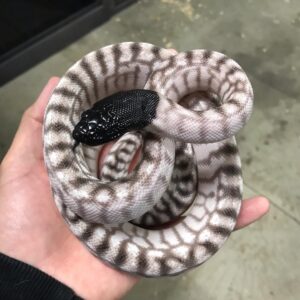

More so,
- Aesthetic Appeal: The Axanthic morph is visually distinctive, featuring a contrasting black and white coloration. This can make these pythons particularly appealing to reptile enthusiasts who appreciate the aesthetics of unique and visually striking snakes.
- Rare and Unique: Axanthic Black Headed Pythons are relatively rare, and their unique appearance sets them apart from more common color morphs. For those seeking a snake that stands out, the Axanthic Black Headed Python can be an attractive choice.
Hence,
- Breeding Projects: Breeders may be interested in Axanthic Black Headed Pythons for their genetics. Breeding an Axanthic snake with other morphs can produce visually diverse offspring with various color patterns, contributing to the diversity of available captive-bred pythons.
Description
The Axanthic Black Headed Python, scientifically known as Aspidites melanocephalus, is a captivating reptile that has garnered significant attention among herpetology enthusiasts. Endemic to Australia, this python species is renowned for its distinctive coloration and unique morphological characteristics. Unlike other pythons, the Axanthic variant lacks yellow and red pigments, resulting in a striking monochromatic appearance that ranges from silver to dark grey, accentuated by its jet-black head.
Primarily found in the northern regions of Australia, including Queensland and the Northern Territory, the natural habitat of the Axanthic Black Headed Python consists of savannas, woodlands, and scrublands. These pythons are well-adapted to their environment, often seeking refuge in burrows or under logs to regulate their body temperature. Their nocturnal nature also plays a crucial role in their survival, allowing them to avoid the harsh daytime temperatures common in their habitats.
Several key features distinguish the Axanthic Black Headed Python from other members of the Pythonidae family. One of the most notable is its smooth, glossy scales, which contribute to its sleek appearance. Additionally, the black head serves not only as a visual identifier but also plays a functional role in thermoregulation. The dark pigmentation allows the python to absorb more heat, which is particularly beneficial during the cooler nights in its natural habitat.
The allure of the Axanthic Black Headed Python extends beyond its physical attributes. Among reptile enthusiasts and breeders, this species has gained popularity due to its docile temperament and relatively manageable size, typically reaching lengths of 1.5 to 2 meters. Its unique appearance and ease of care make it a sought-after addition to both private collections and educational exhibits.
Physical Characteristics
The Axanthic Black Headed Python is a striking specimen, notable for its distinct physical features. Typically, these pythons reach lengths between 1.5 to 2 meters, with some individuals occasionally growing longer. Their build is robust, with a muscular body that tapers to a slender tail, highlighting their adaptability and strength.
The hallmark of this species is its unique coloration, which is significantly influenced by the genetic trait of axanthism. This genetic condition results in the absence of yellow pigmentation, leading to a color palette dominated by shades of black, white, and grey. The lack of yellow pigmentation sets the Axanthic Black Headed Python apart from other python species, giving it a visually captivating appearance.
The most striking feature of this python is its entirely black head, which contrasts dramatically with the rest of its body. The black head is a genetic trait inherent to the species, and it serves as a distinguishing characteristic that adds to the python’s allure. The body pattern varies among individuals, ranging from bands and blotches to more uniform coloration, but the black head remains a constant across the species.
Sexual dimorphism in Axanthic Black Headed Pythons is subtle but present. Females tend to be slightly larger and more robust compared to males, which is common in many python species. This size difference is often noticeable during the breeding season, where the larger females can be seen coiled protectively around their clutch of eggs.
Within the species, there are also minor variations in coloration and patterning, influenced by both genetic factors and environmental conditions. These variations contribute to the diverse and fascinating appearances that make the Axanthic Black Headed Python a subject of interest for herpetologists and reptile enthusiasts alike.
Natural Habitat and Distribution
The Axanthic Black Headed Python is an intriguing species known for its unique coloration and head markings. These pythons are primarily found in the arid and semi-arid regions of Australia. They are predominantly located in the northern parts of the country, spanning across Western Australia, the Northern Territory, and Queensland. These regions are characterized by their dry landscapes, sparse vegetation, and a climate that varies between extremely hot days and cooler nights.
The typical environments of the Axanthic Black Headed Python include rocky outcrops, scrublands, and savannahs. These habitats provide ample opportunities for the pythons to engage in their natural behaviors, such as burrowing and hunting. Burrowing is a significant aspect of their behavior; they often take refuge in pre-existing burrows dug by other animals or natural crevices found in the rocky terrain. This not only offers them protection from predators but also helps them regulate their body temperature amidst the fluctuating temperatures of their habitat.
In terms of diet, these pythons are opportunistic feeders, preying on a wide range of animals. Their diet mainly consists of small mammals, birds, and reptiles. They are known to be nocturnal hunters, utilizing their keen sense of smell and heat-sensing abilities to locate prey in the dark. The Axanthic Black Headed Python’s distinctive black head plays a crucial role in its hunting strategy, as it helps in camouflaging while they lie in wait for unsuspecting prey.
The distribution and habitat preferences of the Axanthic Black Headed Python highlight their adaptability to some of the most challenging environments in Australia. Their ability to thrive in such conditions underscores the evolutionary success of this remarkable species. Understanding their natural habitat and distribution is essential for conservation efforts, ensuring that these fascinating pythons continue to thrive in their native landscapes.
Diet and Feeding Habits
The Axanthic Black Headed Python, known for its distinct coloration and impressive size, exhibits intriguing dietary preferences both in the wild and in captivity. In their natural habitat, these pythons primarily prey on small mammals, birds, and reptiles. Their diet is opportunistic, allowing them to adapt to the availability of prey in their environment. This adaptability is crucial for their survival, as it ensures they can thrive in various ecological niches.
In captivity, maintaining a balanced and appropriate diet is essential for the health and well-being of Axanthic Black Headed Pythons. Typically, a diet consisting of appropriately sized rodents, such as mice and rats, is recommended. These should be fed either live or pre-killed, depending on the python’s feeding response. It is crucial to avoid feeding prey items that are too large, as this can lead to regurgitation or other health issues.
The frequency of feeding for Axanthic Black Headed Pythons varies with age and size. Juvenile pythons generally require feeding every 5 to 7 days, due to their rapid growth rate and higher metabolism. Adult pythons, on the other hand, can be fed less frequently, approximately every 10 to 14 days. Monitoring the python’s body condition and adjusting the feeding schedule accordingly is important to avoid obesity or malnutrition.
Specific dietary requirements for these pythons include ensuring a varied diet to provide all necessary nutrients. Supplementing their diet with occasional offerings of birds or other small reptiles can help mimic their natural feeding habits and provide enrichment. Additionally, always provide fresh water and ensure the feeding area is clean to prevent any health issues.
For those keeping Axanthic Black Headed Pythons in captivity, understanding their feeding habits and dietary needs is paramount. Following a consistent feeding schedule, offering a variety of appropriate prey items, and monitoring their health can help ensure these fascinating reptiles thrive in a controlled environment.
Breeding and Reproduction
The breeding and reproductive behaviors of Axanthic Black Headed Pythons are both intriguing and crucial for anyone interested in herpetoculture. These pythons typically reach sexual maturity between 3 to 4 years of age, with males maturing slightly earlier than females. The mating process usually begins in the cooler months, which can be simulated in captivity by reducing the temperatures slightly and adjusting the light cycles to mimic natural seasonal changes.
During the mating season, males exhibit heightened activity, often engaging in combat with other males to win the favor of a female. Once a pair is successfully bonded, the mating process can last several hours. Following copulation, the female enters a gestation period ranging from 2 to 3 months. It is essential to monitor the female’s health and provide adequate nutrition during this time to ensure successful egg development.
When the gestation period concludes, the female will lay a clutch of eggs, generally ranging from 8 to 15 eggs. The eggs are typically deposited in a secluded, humid environment. In captivity, breeders can replicate this by providing a nesting box filled with damp sphagnum moss or vermiculite. The incubation period for Axanthic Black Headed Python eggs is approximately 55 to 60 days, with optimal incubation temperatures maintained between 82°F to 88°F.
Successful incubation requires careful monitoring of both temperature and humidity levels to prevent desiccation or overheating of the eggs. Once the hatchlings emerge, they should be housed individually in appropriately sized enclosures, with a consistent temperature gradient and access to fresh water. Initial feedings can begin after the first shed, usually within a week of hatching. Offering appropriately sized prey items, such as pinky mice, ensures proper growth and development of the young pythons.
By understanding and replicating the natural breeding and reproductive behaviors of Axanthic Black Headed Pythons, breeders can contribute to the sustainability and propagation of this fascinating species, ensuring its continued presence in both captivity and the wild.
Care and Maintenance in Captivity
Axanthic Black Headed Pythons require specific care and maintenance to thrive in captivity. Proper housing is essential, with enclosures that provide adequate space for movement and exercise. A minimum enclosure size of 4 feet by 2 feet by 2 feet is recommended for adult pythons. The enclosure should be secure, well-ventilated, and escape-proof, with a tight-fitting lid to prevent the python from escaping.
Temperature control is crucial for these reptiles. The enclosure should have a temperature gradient, with a basking spot maintained at 90-95°F and a cooler side around 75-80°F. A reliable thermostat is necessary to regulate these temperatures accurately. Additionally, humidity levels should be kept between 40-60%, which can be achieved by misting the enclosure or using a substrate that retains moisture.
Speaking of substrate, choices such as aspen bedding, cypress mulch, or paper towels can be used. Each substrate has its benefits, with aspen bedding being easy to clean and cypress mulch providing better humidity control. Whichever substrate is chosen, it should be cleaned regularly to prevent the buildup of bacteria and parasites.
Enrichment is important for the mental and physical well-being of Axanthic Black Headed Pythons. Adding hiding spots, climbing branches, and other environmental enrichment items can stimulate natural behaviors and reduce stress. These pythons are generally docile and can be handled with care, but it is essential to avoid overstressing them, especially during feeding times or shedding periods.
Common health issues in Axanthic Black Headed Pythons include respiratory infections, mites, and scale rot. Preventing these issues involves maintaining optimal environmental conditions, regular cleaning of the enclosure, and monitoring the python for any signs of illness. If health concerns arise, consulting a reptile veterinarian is recommended.
With proper care and maintenance, Axanthic Black Headed Pythons can be healthy, thriving pets that offer years of fascination and enjoyment for their keepers.
Behavior and Temperament
Axanthic Black Headed Pythons exhibit a distinct set of behaviors and temperaments that make them both intriguing and manageable as pets. These pythons are generally known for their calm and docile nature, especially when acclimated to human interaction from a young age. Observing their behavior in captivity, one can note their tendency to be more active during dusk and dawn, aligning with their crepuscular habits in the wild. This means they are most lively during twilight hours, making these periods ideal for interaction and observation.
In their natural environment, Axanthic Black Headed Pythons are known to be solitary creatures, spending a significant amount of time hiding under rocks or burrowing into the ground. This behavior is often replicated in captivity, where they appreciate enclosures with ample hiding spaces. Providing such an environment is crucial, as it helps reduce stress and makes the python feel secure. It’s common for these pythons to display a certain level of curiosity, often exploring their enclosure and occasionally interacting with their human caretakers in a non-aggressive manner.
When it comes to socializing and training Axanthic Black Headed Pythons, patience and consistency are key. Regular, gentle handling can significantly improve their comfort levels with humans. Start by introducing short handling sessions, gradually increasing the duration as the python becomes more accustomed to the interaction. It’s important to be mindful of their body language; signs of stress, such as rapid tongue flicking or defensive posturing, indicate that the python needs a break. Ensuring that handling sessions are calm and positive experiences will help in fostering a bond between the python and its owner.
Moreover, maintaining a routine can greatly benefit these pythons. Regular feeding schedules, consistent enclosure maintenance, and predictable handling times create a stable environment that promotes their well-being. Understanding and respecting the natural behaviors of Axanthic Black Headed Pythons not only enhances their quality of life but also ensures they remain healthy and stress-free in captivity.
Conservation Status and Ethical Considerations
The Axanthic Black Headed Python (Aspidites melanocephalus) is a remarkable reptile that captivates enthusiasts with its unique coloration and intriguing behavior. Understanding its conservation status is crucial for ensuring the species’ long-term survival. In the wild, these pythons are primarily found in the northern regions of Australia, where their population is currently considered stable. However, like many species, they face potential threats from habitat destruction, climate change, and illegal poaching, which could impact their natural population dynamics.
Given their stable status, Axanthic Black Headed Pythons are not currently listed as endangered or vulnerable. Nonetheless, preserving their natural habitat is essential to avoid future risks. Efforts to protect their environment include enforcing legal protections, promoting sustainable land use practices, and engaging local communities in conservation initiatives. Such measures help maintain the delicate balance of ecosystems where these pythons play a critical role as both predator and prey.
Ethical considerations come into play when discussing the captivity and breeding of Axanthic Black Headed Pythons. As exotic pets, they require specialized care, including appropriate housing, diet, and environmental conditions to thrive. Potential owners must thoroughly educate themselves on these requirements and be fully committed to meeting the needs of these reptiles throughout their lifespan, which can exceed 20 years.
Moreover, ethical breeding practices are paramount to prevent inbreeding, genetic disorders, and the spread of diseases. Reputable breeders adhere to guidelines that promote genetic diversity and the health of their animals. Prospective pet owners should seek out breeders who prioritize the welfare of their pythons and can provide documentation of their breeding practices.
Supporting ethical breeding not only ensures the well-being of captive pythons but also reduces the demand for wild-caught specimens, thereby alleviating pressure on natural populations. By fostering a culture of responsibility and ethical stewardship, enthusiasts and conservationists alike can contribute to the sustainable future of the Axanthic Black Headed Python.



